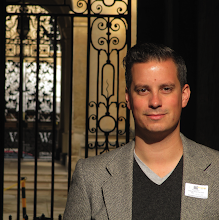In my Street Talk a few months ago I laid out the argument that the urban realm we find ourselves cycling through is not merely an unhappy coincidence but in fact the accumulative consequence of a series of design choices. Speed limits are chosen, the width of pavements are chosen, pedestrian railings don't just land as though from outer space but someone, somewhere - whether making an active choice or just following an engineering manual to the letter - makes the decision to install them.
Recently, some of the greatest minds thinking about cities today gathered in a disused power station in Shoreditch for the Urban Age Electric Cities conference, hosted by the LSE's Cities programme, sharing their insights in to how we live and move in the urban world. (Our contribution to Electric Cities were some thoughts on the convergence between bicycles, smart phones, information and transportable power, which you can read here)
German typographer Erik Spiekermann is an expert in how we read things, and how we translate what we see. He's been designing fonts and looking at the layout of information on pages his entire career. He argues that we navigate through information presented on a screen or a page in a certain way, that there are certain logics and patterns at play, which can be scaled up and transferred to the city around us. In this video of his presentation at Electric Cities he argues that encouraging people to explore their cities can not only lead to a healthier population but also to a more cohesive urban community. Someone who uses the phrase "Only the fascist squares of the world are actually square... ...in East Berlin we built eight lane highways though we only had two cars" was almost guaranteed to grab my interest, but I encourage you to watch his talk and think about how some of his lessons can be applied to cycling;
Most people in London will be familiar with the Legible London maps which Mr Spiekermann refers to, pictured above, and the ease with which people can use them to find a route between a known starting place and a known destination. Is the fear and ignorance of the "blanks" in our mental picture of the city, or gaps in knowledge between destinations something that could be discouraging more bicycle use and walking? If bicycles can help to connect neighbourhoods, could more bicycle use lead to new transportation patterns in a city? As the "sharing model" of hire bicycles and hire cars become more and more prevalent will the systems improve because of their focus on end-user usability, or will they simply succeed by virtue of being ubiquitous?
These questions and more are all worth our consideration as we move towards a more bicycle-friendly city, as we remember that the spaces between buildings don't just happen but are chosen. In the future our city must make the choice between whether the streets are somewhere that invite more walking and cycling, or if they are somewhere that walkers and cyclists must tolerate.
Share |
Recently, some of the greatest minds thinking about cities today gathered in a disused power station in Shoreditch for the Urban Age Electric Cities conference, hosted by the LSE's Cities programme, sharing their insights in to how we live and move in the urban world. (Our contribution to Electric Cities were some thoughts on the convergence between bicycles, smart phones, information and transportable power, which you can read here)
German typographer Erik Spiekermann is an expert in how we read things, and how we translate what we see. He's been designing fonts and looking at the layout of information on pages his entire career. He argues that we navigate through information presented on a screen or a page in a certain way, that there are certain logics and patterns at play, which can be scaled up and transferred to the city around us. In this video of his presentation at Electric Cities he argues that encouraging people to explore their cities can not only lead to a healthier population but also to a more cohesive urban community. Someone who uses the phrase "Only the fascist squares of the world are actually square... ...in East Berlin we built eight lane highways though we only had two cars" was almost guaranteed to grab my interest, but I encourage you to watch his talk and think about how some of his lessons can be applied to cycling;
Most people in London will be familiar with the Legible London maps which Mr Spiekermann refers to, pictured above, and the ease with which people can use them to find a route between a known starting place and a known destination. Is the fear and ignorance of the "blanks" in our mental picture of the city, or gaps in knowledge between destinations something that could be discouraging more bicycle use and walking? If bicycles can help to connect neighbourhoods, could more bicycle use lead to new transportation patterns in a city? As the "sharing model" of hire bicycles and hire cars become more and more prevalent will the systems improve because of their focus on end-user usability, or will they simply succeed by virtue of being ubiquitous?
These questions and more are all worth our consideration as we move towards a more bicycle-friendly city, as we remember that the spaces between buildings don't just happen but are chosen. In the future our city must make the choice between whether the streets are somewhere that invite more walking and cycling, or if they are somewhere that walkers and cyclists must tolerate.
Share |





No comments:
Post a Comment